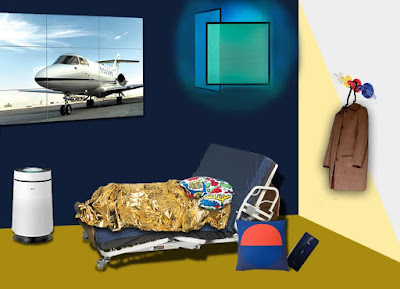In image above: Suda Kenji, (born 1954),Toho no Hinode (Eastern Sunrise), 2015. Chest of drawers with inlay decoration made by Sycamore wood, private collection. From the exhibition "Decorative arts in Meiji and Heisei: Crafting Beauty and Technique across 150 years", in Museum of Greek Modern Culture, Athens, Greece, until 12/1/2020.
The myth tells that in Pandora’s box the last remaining thing after the release of all vices – was Hope. In case where all the vices were set to escape Hope would stay at the side of humanity as a faithful companion intrusting that things could always change for the Best. Is there any hope for the Design of the future? How this last one will shape the rising decade?
The major transition from Liberalism to Freedom Values and from the Industrial Revolution to the Digital Technologies, re-defines the set of known Tools as Apps and those Apps as the new Tools that will serve us in the future, on an everyday basis. The Cashless transition from bank notes and coins (very expensive and climate-affective in production) to non-material Currencies is a certainty and a “problem” tantalizing the traditional banking establishment. Sustainability becoming an almost (vague) trend and an expression of concern regarding climate change, gives room to non-stop Recyclability (not just one stage process stage but a continuous non-stop and on-going cycle of the materials’ life). Old crafts and hand-made work will merge into New Crafts, where manual work will be done and finished differently through upcoming hybrids of technique and digitization.
In communication design, "The Medium is the Message" of the 70’s is replaced already by "The message is the Message": the notion of Medium is collapsing under the existence of one common server with un-curated content, accessed by all possible devices (i.e the YouTube platform). Documentation in AI and intelligent digital environments pushes away Museology as instructed in the past, the same way corporate environments switch to online/cloud/blockchain services.
The educational model is about to change in developed countries, where higher education is becoming a social exercise: schools are social clubs, universities are cultural foundations and public libraries work as lifelong learning and public administration poles. The interest in knowledge is nourished through a re-designed homeschooling experience.
The irresponsible and unorthodox exploitation of natural resources, together with the abuse of durable, multi-purpose materials such as plastic, resulted in the disastrous consequences of climate change and irreversible ecological distress. We need to leave the planet alone for at least 100 years, in order to recover and Fashion is one of the sectors about to change dramatically towards that principle. The way we design and produce clothes inside the supply chain cycle, is about to change focusing on pre-owned garments, thrifting, smart fabrics design, wearables and textiles' engineering both in couture and high street houses – so we can have a life guarantee for the future. New clothes will represent the 25% of global production the next decades, while the 75% in fashion will represent jobs in the industries above.
The abolition of fossil fuels and livestock/plant industrialization and the rise of renewable energy, hydroponics and short-term supply chain, are a staple in the design agenda. The pharmaceutical industry will invest on restorative, naturopathic solutions for cure and on the scientifically proven benefits of painkilling meditative devices/apps.
From Cities to Places, from Credit to Trust
The physiognomy of the city of the Future, provided the multiple challenges of our times, will have to change: architecturally, socially, intellectually. Cities gradually lost their Soul, so did the Psyche of each nation and eventually they became unsuitable and unbearable to live in. The urban manipulation in the design of a town the last decades alienated it from every notion of becoming a good Place, but contributed to the image of a city just deteriorating, on finally becoming decadent. The “Darius Syndrome” of architects and politicians just watching the “slaughter from up on a hill”, observing the big cities’ downfall outside the actual urban systemic infrastructure, from the rather comfortable distance of the “specialist” – failed to design a place for civilians to resist Time. Instead they designed a congregation of ambitious buildings and uncomfortable surroundings, with total luck of prediction nor compassion for the nature and the people. The next decade is about to convert the activity of “arrogant” metropolises and its many entanglements, so to advance to a more person-friendly, “therapeutic” model.
The countdown has started.
HAPPY NEW YEAR 2020!
A4D-D4A💙💚💓









































